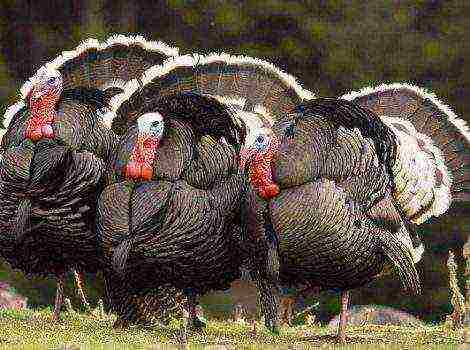Content
- 1 1. Do not plant grapes anywhere
- 2 2. Choose varieties that are suitable for your region
- 3 3. Increase the sum of active temperatures
- 4 4. More light!
- 5 5. Don't forget about watering
- 6 6. Competent pruning
- 7 7. Garter grapes
- 8 8. Can't there be too many crops?
- 9 9. Invisible dangers ...
- 10 10. Do not get carried away with feeding
- 11 What should you consider before growing grapes?
- 12 Step-by-step technology for growing grapes
- 13 How to properly grow and care for grapes?
.
Are you a beginner gardener and decided to start growing grapes? In this article, you will find step-by-step instructions, following which you will get great results.
Much of the cultivation process depends on the climate in which you live. The easiest way to grow grapes is if you live in the warm south. Growing shrubs is much more difficult in temperate and cold climates. But nothing is impossible if you follow the advice below from experienced gardeners and winegrowers.

It is recommended to plant grapes from the south and southwest side
Choose your planting site carefully
You should choose the warmest and sunniest place. It is recommended to plant grapes from the south and southwest side. An excellent site for planting would be a site near a stone wall of a house or near a fence. This planting option is able to protect the shrub from the adverse effects of winds and drafts from the north side and this will allow the plant to receive heat from the building (brick house, for example).
Planting grapes near trees is not recommended, because light and nutrients present in the soil will be in short supply.
The cultivated root system of the shrub is capable of growing several meters into the ground. Grapes do not like the abundance of moisture in the soil. As a result, groundwater should be at least 2 m from the earth's surface. Let us remind you again: from this point of view, it would be ideal to plant a shrub near the wall of the house.
Choose the variety that's right for your area
Research the variety and characteristics of grape varieties before purchasing and planting a shrub. The choice should be made in favor of unpretentious varieties that are resistant to most diseases and pests, and most importantly - suitable specifically for your climatic zone. Excellent, from this point of view, grape varieties are:
- Arcadia;
- Isabel;
- Lydia;
- Moldova.

Excellent grape variety - Lydia
If you plan to make wine, then you need to grow grapes of special technical varieties.
Watch the temperature
Remember that grapes love:
- warmly;
- moisture;
- timely feeding.
Therefore, you must monitor the temperature regime that is created for it, water it so that the ground remains moist, but do not flood the plant, excess moisture will lead to decay of the roots. Do not forget about plant feeding, because grapes are a southern culture and the lack of heat must be compensated for by frequent fertilization.
It is recommended to plant a shrub:
- on the southern slopes;
- next to the fence;
- near the fence (fence);
- under the walls of the house.
For better stability, growers are advised to lay stones around the plant. You need to cover the ground around the shrub with roofing felt to create a suitable microclimate and protect against weeds. Plant the grape bushes in beds about 30-50 cm high. This is necessary for better soil warming.
The most acceptable temperature for growing grapes is 28-32 ° C.
Help in maintaining the temperature regime will be provided by a simple structure called the "bottle stove". Along the length of the central bed of grapes, with an interval of 50-60 cm from the bushes, you should submerge glass bottles that you can find at home 2/3 into the ground with their necks down. On a clear day, warm air will penetrate to the roots, further warming them up.
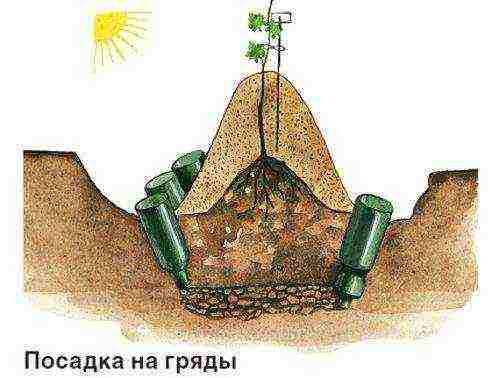
Through glass bottles, warm air will penetrate to the roots, further warming them
Maximize light access to the bushes
Light is just as important to grapes as warmth. Therefore, shrubs should be planted in a row from north to south. The intervals between them should depend on the planned dimensions of the bushes themselves. As a rule, seedlings are placed at a distance of 1.5-2 m, otherwise the sunlight will not spread to other bushes.
In one season, grapes need at least 1,600 hours of sunshine.
Timely watering is the key to the health of the shrub
Water the grapes with care. The root system of the shrub is very sensitive to excess moisture and its lack. Particularly carefully and carefully it is necessary to irrigate the plant in the first year of ripening. Make a small hole in the ground near the grapes about 20-25 cm deep and pour in some water. Remember that one bush needs from 5 to 15 liters of water... As the water is absorbed into the soil, gradually sprinkle the trough with earth and loosen the soil near the bush, providing oxygen to the roots. In hot weather, grapes need 50 liters of water per square meter.
Prune your vines correctly
For novice wine growers, it will be useful to remember some rules for pruning grapes. When pruning vines in the fall, you need to leave 3 shoots that have developed in the current year. For fruiting, you need to cut two shoots long and keep 6-8 buds, and cut the third short, about 3 buds (this is for replacement). A year after this procedure, save 3 shoots from the short vine, and cut off the rest completely. Then repeat this simple pruning scheme every year for a beautiful and high-yielding vine.
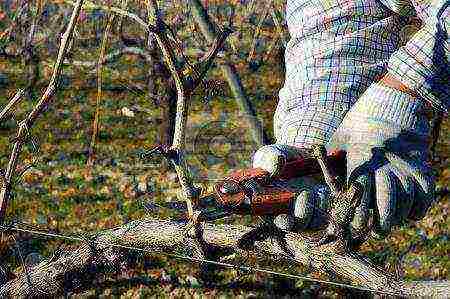
Pruning gives the vines access to sun and fresh air
Tie the grapes correctly
For beginners, the easiest way would be to tie the grapes at an angle of 45 degrees (it is especially successful to do this near the fence or wall of the house). By the way, it is with such a garter that the sugar level in the berries rises. There is another version of the garter - horizontal. This method will allow you to get the maximum yield of grapes. However, for novice winegrowers, it is not entirely appropriate, since you also need to monitor the timely collection of the harvest, which will ripen quite often.
Adjust the amount of harvest by pruning the vine
Every gardener dreams of collecting the maximum amount of harvest from one grape bush and preserving the attractive appearance of the vine. There is an opinion that the more shoots you save on the vine, the more berries you can collect from the bush. Unfortunately, this opinion is incorrect. In many cases, the vine cannot bear the weight of full bunches, and as a result, it weakens, begins to succumb to the attacks of insect pests and withers by winter. Nobody can say unequivocally how many bunches to leave and how long the vine can be, because all varieties, ages of shrubs and the climate in which these or those plants grow are different. Typically, gardeners can yield yields by properly pruning the vines. With a short pruning, it is advisable to keep 3-4 buds on the process, with an average - 5-10 eyes, with a long one - 10-12 buds. The most acceptable is the medium cut. Sometimes neat and painstaking gardeners collect up to 100 kg of berries from one grape bush.

Leaves are pruned to ensure future grape harvests
Protect grapes from invisible dangers
Gardeners do not always notice in time that their shrubs are affected by insect pests or the plant is sick.Even experienced winegrowers rarely manage to avoid bush diseases. When the air temperature is below 15 ° C, it is necessary to do preventive treatments of the plant 1-2 times in 7-10 days. A remedy that does not contain chemicals will help to cope with fungal diseases. Fill a bucket of water with shredded weeds or cut grass and stir. Let the mixture sit. For the desired effect, it must become cloudy. She needs to spray the shrub during the growing season. It is worth remembering pests such as ticks and methods of dealing with them.
Calculate the amount of fertilizer rationally
It is recommended to fertilize grapes with fertilizers in small doses. This should be done regularly. In the spring, you need to add fertilizers under each bush: nitrogen, potash and phosphorus. After that, cover everything with earth. 10 days before flowering, you need to sprinkle the soil with such fertilizers (in a proportion of 40:50:30 grams). Then water the shrubs generously.
Subscribe Be aware of new products on our site
Many people try to grow grapes, but not everyone succeeds. We have prepared ten tips to guarantee you a great result.
So you've decided to tackle grapes. It is good if you live in the warm south - it is easier to grow the beloved fruits of the god of wine there. In temperate and cold climates, grapes are usually more of a concern than growing dividends. However, you can try to "deceive" the grapes and make it seem to him that he is growing in a fertile atmosphere for him. To do this, you need to follow the following guidelines.
1. Don't plant grapes anywhere
The place for planting grapes should be the warmest and sunniest on your site. The southern and southwestern slopes are considered optimal. A good option is to plant the plant against a stone wall or fence that will protect the vineyard from the north side. In this case, the grapes will receive additional heat from the structure, it will also protect it from gusts of north wind and drafts. You should not plant grapes next to trees - their crowns will obscure the sun, moreover, the grapes may not have enough nutrients from the soil.
Sometimes there is no other place for grapes on the site except at the roadway. In this case, you need to take care of the fence of the plant. It is best to do this with a hedge, so that trees and shrubs do not cast a shadow over the vineyard, but at the same time protect it from dust.

European and Asian grape varieties like slightly alkaline soil, American varieties like acidic
Grapes have a developed root system, which sometimes penetrates the soil for several meters and reacts negatively to excess moisture in it. Therefore, groundwater should be located no closer than 2 m from the earth's surface.
2. Choose the varieties that are right for your region
Do not rush to buy the first grape seedling you see. Find out which varieties do well in your climatic zone, how resistant they are to diseases and pests (especially phylloxera), which of the recommended varieties are the most unpretentious. Maybe your neighbors have been successfully engaged in viticulture for a long time and will be able to share some secrets. Moldova, Arcadia, Memory of Negrul, Italy, Lydia, Isabella are considered good and unpretentious grape varieties.
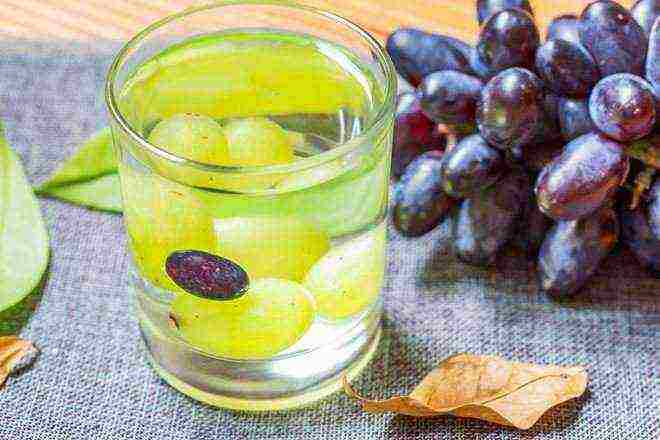
If you are going to grow grapes exclusively for making wine, choose special technical varieties
3. Increase the sum of active temperatures
There is a simple truth behind this complex structure - grapes love warmth, therefore, their personal "summer" must be constantly extended.
Plant seedlings on the southern slopes, close to the walls of the house and fences on the south side, lay stones around them.Cover the soil around the bushes with spunbond or roofing felt to create a favorable microclimate and not let the weeds negate all your efforts. Form the grape bushes on ridges 30-50 cm high so that the soil warms up better.
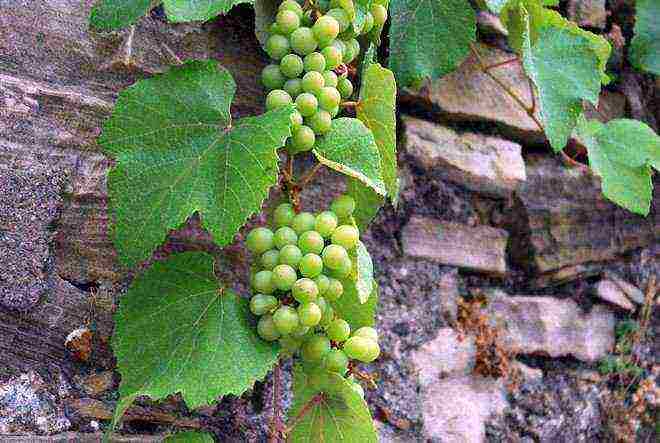
During the growing season, the optimum temperature for growing grapes is 28-32 ° C
Make a "bottle stove" - along the main ridge with grapes, at a distance of 50-60 cm from the bushes, immerse glass bottles with their necks down by 2/3. On a sunny day, warm air will flow to the roots, further warming them up.
4. More light!
Light comes second after warmth. Therefore, the vines are arranged in a line from north to south. The distance between the bushes is selected depending on what size the bushes are planned to be formed. Usually, seedlings are planted at a distance of 1.5-2 m, but not less than 1 m, otherwise the sun will not be enough for everyone.

Grapes require a minimum of 1,600 hours of sunshine per season.
When planting bushes from east to west, you will need a reflective screen and protection from the wind from the north side. A sheet of slate or other similar material will do the job of a "shield" - it will redirect light and heat towards the landings.
5. Don't forget about watering
Water the grapes carefully. A powerful root system makes this plant very sensitive to both excess and lack of moisture. Pay special attention to watering in the first year of grape ripening. To begin with, at a distance of 25-30 cm from the bush, make a hole 20-25 cm deep, and carefully pour the required amount of water into it. One bush will require from 5 to 15 liters of water. In the first year - 10 liters per bush, in the second year - 20 liters per bush. After the third year, reduce the watering intensity to 5-8 liters. When the water is absorbed, cover the hole with earth and slightly loosen the soil around the bush so that air can flow to the roots.

In summer, grapes require 50 liters of water per square meter.
6. Competent pruning
For beginners, Guyot shaping is the preferred method. When pruning in autumn, leave 3 shoots that have formed in the current year. Cut two long, for fruiting, leaving 6-8 buds, and the third short, for replacement, for 3 buds. After a year, also leave 3 shoots from the "short" vine, and remove the "long" (fertile ones). Form the remaining three, as in the beginning - two long sleeves and one short one. And so every year.

It is impossible to get a good grape harvest without pruning.
7. Garter grapes
The simplest entry-level garter is at a 45-degree angle. In some cases, it allows you to get rid of the normalization of the bush by shoots and crops. With a horizontal garter (parallel to the trellis), all the "eyes" on the shoot wake up and the yield is maximized. Therefore, you should harvest in a timely manner.
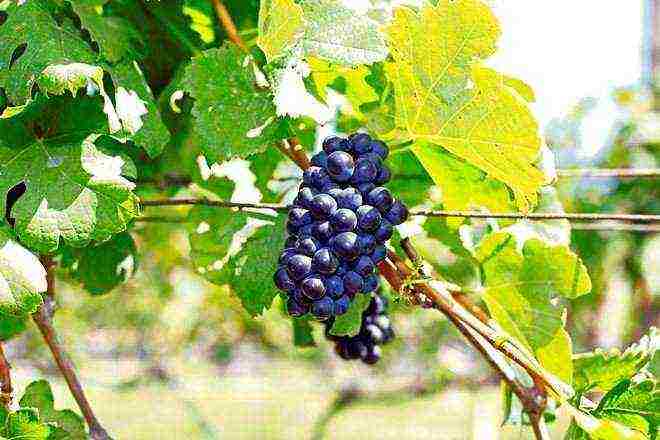
You can tie grapes vertically, horizontally and at an angle of 45 °
It is believed that perennial and annual vines tied at a 45-degree angle increase the sugar level in the berries.
8. There is never too much harvest?
Perhaps one of the main problems of gardeners is the desire not to harm the bushes by excessive, "bare" pruning and at the same time to collect the maximum yield. Say, the more shoots I leave, the more berries I will collect. Alas, this is not the case. The vines cannot support the weight of the juicy bunches, they weaken, cease to resist disease and wither in winter. There is no universal recipe, since all varieties are different, as well as the age of the plants, growing conditions and climate. The length and number of fruiting branches must be adjusted by pruning. So, with a short pruning, 4 buds are left on the shoot, with an average - 5-10, with a long one - more than 10 eyes. Medium pruning is considered optimal. As a result, a young bush has an average of 30-35 eyes, a middle-aged one - 45-50, and an old one - 60-75 or more.

In exceptional cases, up to 100 kg of berries can be harvested from one grape bush
9. Invisible dangers ...
... which primarily include diseases and pests. It is very difficult to avoid grape diseases, alas. In an unfavorable period (temperature below 15 ° C), preventive treatments should be carried out 1-2 times every 7-10 days. There is an interesting recipe for fungal diseases that allows you to do without "chemistry". Fill a container with water (8-10 liters) with chopped weeds or cut grass, add a glass of kombucha tincture and let the solution stand for several days until it becomes cloudy. Dilute it with water in a ratio of 1: 7 and spray the plants during the growing season. Do not forget about pests of grapes and measures to combat them.
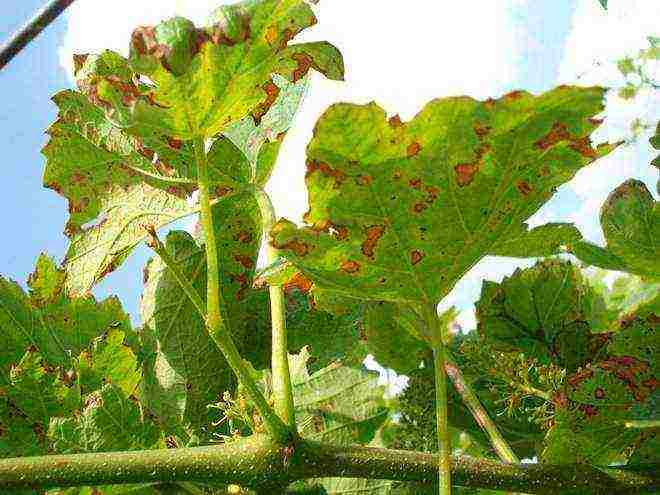
The yellowing and unhealthy appearance of the bushes sometimes indicates a micronutrient deficiency.
10. Do not get carried away with feeding
The desire to "help" the grapes is understandable and noble. But it is better to apply mineral and organic fertilizers in small doses and regularly than to immediately give "horse" volumes. So, in the spring, immediately after the opening of the grapes, under each bush, add 50 g of nitrogen, 30 g of potash and 40 g of phosphorus fertilizers (and be sure to sprinkle them with earth). 10 days before flowering, apply 40 g of nitrogen, 50 g of phosphorus and 30 g of potassium fertilizers under each bush. Then water the grapes liberally. During the ripening period of the berries, apply 50 g of phosphorus and 50 g of potash fertilizers under each bush.

It is best to feed the grapes with complex fertilizers (Nitrofoskoy, Ammophos)
Follow these simple tips and the "fruits of Dionysus" will delight you with a magical and unique charm of taste.

Growing grapes is not as difficult as it is commonly believed. Large bunches with juicy fruits will brighten up your vineyard if you follow the basic rules carefully, taking into account the advice of experienced growers.
What should you consider before growing grapes?
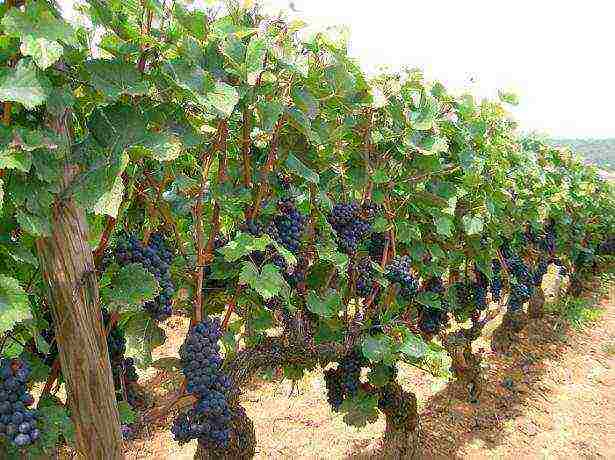
Vineyard photo
Why does not every gardener manage to grow good grapes on their plot so that they do not freeze over the winter, do not rot in the summer and bring a bountiful harvest of decent quality? The fact is that the cultivation of this culture must be taken seriously.
First of all, you should choose a suitable grape variety that will feel comfortable in your area. For instance, growing grapes in the middle lane gives good results only when using winter-hardy varieties with early ripening. Among the new varieties, you will find many excellent options that are resistant to fungal diseases, pests and severe frosts, with high yields and the ability to ripen even in a cloudy short summer.
Video about growing grapes
Black varieties tend to require more sunlight and warmth than light grapes, although there are some hardy black varieties.
Pay special attention to the appearance of the seedling when buying. Look for any mechanical damage, signs of drying or strange stains on the plant? Healthy grape seedlings should have at least three well-developed roots and a shoot about half a meter high. In order not to doubt the quality of the planting material, buy seedlings in the nursery, and preferably in a container - this way the plant will take root better.
It will be easier for a beginner gardener to plant a ready-made grape seedling, especially if you want to create a vineyard from scratch. Experienced growers can easily cope with cuttings, but those who are not afraid to experiment can try growing grapes from seed.

In the photo grape seedlings
Step-by-step technology for growing grapes
When starting to create a vineyard, it is important to take into account the climatic features: if the region is characterized by little snowy winters and severe frosts, it would be preferable to plant grapes in trenches or holes, but if there is enough snow in winter, but the summer is too short and cold, it is better to plant seedlings in bulk ridges. In the pits, the root system will be reliably protected from freezing, and in the ridges, the roots will receive more heat during the summer months.
You can plant grapes both in spring and autumn, depending on which planting material you have chosen. Consider the most common and simplest option - the autumn planting of grapes with seedlings in planting holes.

In the photo, planting grapes
Stages of planting a grape seedling:
- choose for planting well-lit by the sun, a flat place where there are no drafts and excess moisture;
- dig a planting hole according to the size of the root system, with a depth of 0.2 to 0.5 m (less for clay soil, deeper for sandy);
- mix the soil from the pit with organic and complex mineral fertilizers;
- put a layer of gravel on the bottom of the hole, and put branches or planks on top;
- install a pipe with a diameter of 10 cm or more in order to water the grapes and fertilize the soil through it;
- form a small mound of prepared earth on top of a layer of gravel and branches;
- before planting, dip the roots of a grape seedling in a solution of clay and rotted mullein (clay is twice as much as a mullein);
- cut the shoots into a couple of buds and dip them in melted paraffin;
- place the seedling in the hole, spreading its roots;
- fill the hole with the remaining soil and tamp it carefully;
- pour warm water over the grapes;
- cover the hole with compost or rotted manure.
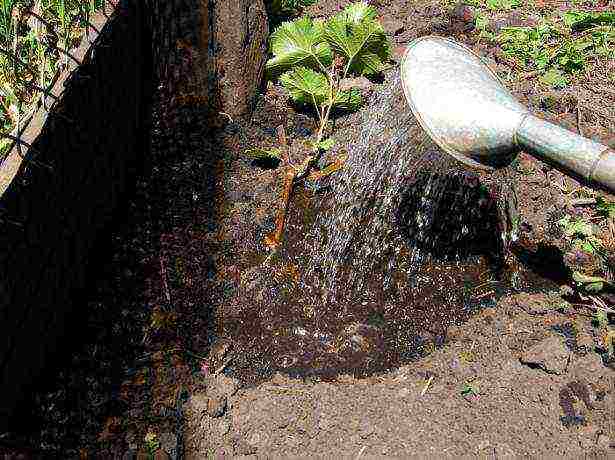
Photo of watering grapes
If you are going to plant several bushes of grapes, leave at least one and a half meters between them. At the same time, it is recommended to arrange plants from south to north.
How to properly grow and care for grapes?
For the proper formation of the vines, it is necessary to install a solid trellis. The simplest construction consists of two metal or wooden posts with several rows of wire between them. As the vines grow, they are neatly tied to a wire, giving them the desired direction.
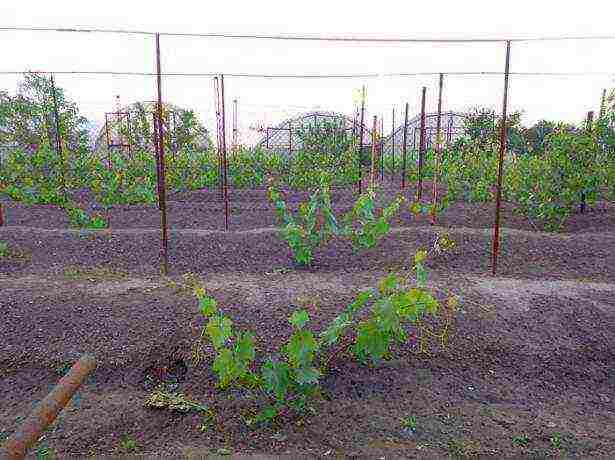
In the photo grapes
In the first three years, pay particular attention to planting: carefully loosen the ground two days after rain or watering, do not allow leaves to wither and dry out the soil from lack of moisture, destroy weeds. Starting from the fourth year, it is sufficient to water the vineyard three to four times per season during the most important phases of development.
Periodically, the vines should be fed through drainage pipes and along the leaves, and treated with suitable fungicides against pests and diseases. Inspect the plants more often in order to start the fight against dangerous enemies of grapes in time and prevent the death of the entire vineyard!
Video about the technology of growing grapes
Prune the grapes every fall after the fall. With the onset of the first night frost, remove the vines from the supports, pin them with brackets to the ground, treat with a solution of copper sulfate and cover with plastic wrap. In spring, do not rush to open the grapes until frosts and sudden changes in temperature stop.
By following the grape growing technology outlined in this article, you can create your own vineyard and enjoy delicious, juicy fruits every year.
Rate the article:
(7 votes, average: 4 out of 5)
The extreme climate of a sunny berry is not a hindrance. And getting a good grape harvest in the second or third year after planting is an achievable goal even for beginners. So, how to stop dreaming and start growing grapes ...
First, let's decide on the two most important tasks in growing grapes - we will choose a place for planting grapes and the varieties that we will plant. In principle, the vine will grow almost everywhere (except for a solid shade), and if you take care of it, at the very least it will bear fruit. However, competent planting in the right place will allow you to get really good yields with much less effort. Remember that planting seedlings of low-quality varieties in a vineyard will take your time, energy and good mood. You may be unfairly disappointed in grapes, although the mistake will be entirely yours.
Place for planting grapes
The vineyard should be sunny and sheltered from the wind, for example by the south wall of a house, a barn or a south-facing fence with well-drained soil. If there is a minimum slope on the site, plant the grapes on a gentle southern or south-western slope, orienting the row in a south-north direction. If the plot is flat and the southern walls are occupied, create a place for your grapes by building in any convenient place on the plot a nice solid fence 1.8–2 m high, oriented along the "east-west" line. And you will immediately understand the secret of the monastery vineyards! You can also use for this purpose dense hedges or screens from available materials, for example, from vines or reeds.
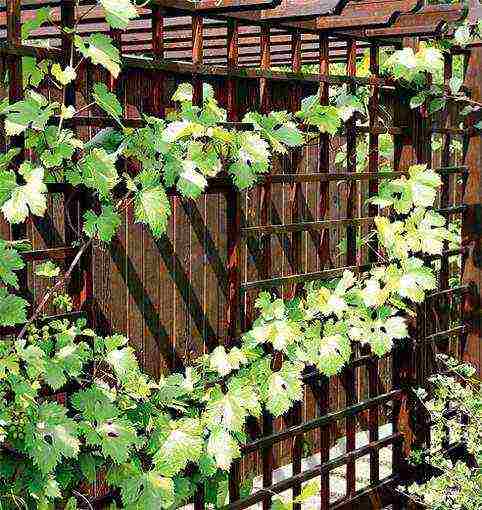
Tips for a new wine grower
-
The method of planting grapes depends on the type of soil. Variants are possible, but usually it is recommended to plant grapes on sandy soils in trenches, and on poorly heated loams and clays and in areas with a close occurrence of groundwater, it is recommended to plant on ridges, which in the old days were called "created".

For watering and fertilizing the grapes, I place plastic bottles with a cut-off bottom between the seedlings. For table varieties, as the bushes grow older, I replace them with asbestos-cement pipe trimmings, and for “techies” (wine varieties) I remove them altogether after three years. Mature wine grapes have to get their own water from the soil, and the deeper the roots, the better the wine from its berries.
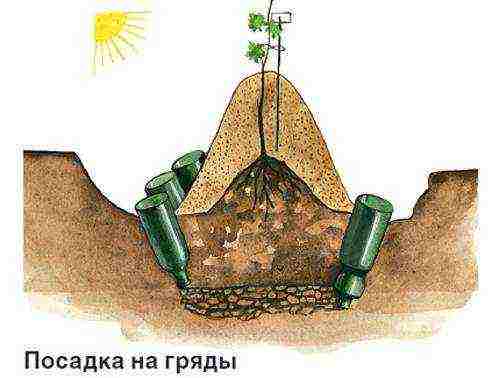
-
Do not rush to plant seedlings "for permanent residence", especially if these varieties are on trial. Let them live until the first signal brushes in the school (where it is easier to cover). In the first year, some northerner growers do not plant seedlings in open ground at all, but keep them there in mobile containers (for example, in buckets), half buried in the ground. In autumn, containers with seedlings are moved to the basement, and in late spring they are planted. Such seedlings begin bearing fruit earlier.
-
Don't spontaneously plant vines. If your grape bushes are not in a "spot" planting, planning of the vine plot is necessary. Group varieties by purpose, as they have different planting intervals. The distance between bushes of varieties for juice and wine purposes is 0.8 m, for table varieties - at least 1.5 m, between rows - 2–2.5 m. It is advisable to clarify the strength of growth of the selected varieties in order to correctly calculate the desired place. Grouping varieties by ripening and frost resistance will facilitate the care of the grapes. You will not need to spray and cover everything to the maximum.
-
Do not plant grafted seedlings (from European and southern nurseries) vertically, but place them practically lying at the maximum possible angle, otherwise there will be problems with the ripening of the vine. Gradually translate them into your own roots.
- Remember that grapes have the property of vertical polarity. When opening, tie a fruitful arrow on a trellis or stakes only horizontally - then all annual green shoots will grow equally. With a vertical garter, shoots grow intensively only from the upper eyes, and from the lower ones, they grow weakly or do not grow.
-
Limit watering. It is only necessary to water the young vines for the first 2 years and the water-charging watering, which is common for all varieties, in the fall. Stop watering 7-10 days before the expected flowering, as excessive moisture causes the color to shed and delays the ripening of the crop.
-
Do not use sprinkling, otherwise you will provoke disease. Arrange drainage channels and place irrigation pipes on the side of the row spacing no closer than 30-50 cm to the base of the bush. Grapes do not like wet leaves and damp ground surfaces. If possible, arrange a visor over the grape bushes.
-
Conduct green operations sparingly and on time. Simultaneous removal of all growth points on the shoot is unacceptable: both chasing the top and pinching the stepsons. After all, there is a danger that the wintering buds of the bush will start to grow and its potential will drastically weaken.Do not break the stepchildren completely, leave 1-2 sheets. Carry out minting in August, immediately after straightening the crown.
-
Pruning the grapes is necessary, otherwise the berries are crushed, and the bush will grow unnecessarily. But in the year of planting, there is no pruning, except for the removal of unripe green parts of the shoots in the fall. From the 3rd year, prune the shoots according to the recommendations (short or long pruning), but do not mindlessly follow the recommended total load, since your conditions - relief, soil, the sum of active temperatures (CAT) - will correct it. Write down from which bud the fruiting shoots grow specifically for you.
Read more: Pruning grapes for beginners .
-
Do not carry out autumn pruning before natural leaves fall or night temperatures are below freezing (early November). Do not prune in the spring, as the "crying" of the vine (sap outflow) weakens the plant.
Read more: How to stop the crying vine>.
-
In the north, it is more reliable to use non-standard formations of a fan or semi-fan type, rather than high-standard ones, including for arbors.
Read more: Cordon formation and pruning of grapes.
Read more: Forming grapes for growing on a gazebo>.
-
Winter shelter for the first 2-3 years is needed for all seedlings. The first year the grapes grow tied to a temporary trellis. In autumn, shoots are removed and covered with a two-three-layer air-dry shelter. As a bedding - spruce branches or boards, on top of the seedlings - a layer of spunbond or corrugated cardboard and a film on top (roofing paper, old linoleum). Snow will complete the rest. Leave ventilation slots at the ends of the shelter.
-
Do not remove the cover immediately and completely in the spring. And when removed, leave a couple of layers of spunbond or lutrasil nearby in case of frost.
- Record the timing and characteristics of planting, flowering, ripening, pruning and loading of grapes in a diary. Otherwise, the most valuable information for the analysis of variety testing will be forgotten and lost. And you and the next generation of northern winegrowers, who will definitely come after you, need it so much.
How to grow grapes in the middle lane.
Winter hardy grape varieties
The most necessary requirements for grape varieties in the Moscow region and to the north are frost resistance, the ripening period of the crop and vines. But you shouldn't put so-called “non-concealment” at the forefront. This concept is relative and does not depend on the variety, but on what are the minimum temperatures in winter in your country house. In the first step, choose the earliest frost-resistant varieties. Later, with experience, the understanding will come that northern viticulture also provides us with certain bonuses, for example, in the form of long daylight hours, which partially compensates for the missing warmth of the grapes. And then you can try growing later varieties.
In addition, in the north, there are practically no diseases and pests of grapes. However, it is always better to prevent danger. There are so-called complex-resistant grape varieties - with high resistance to both frost and disease.
Learn more about grape diseases and how to treat them.
Also determine the purpose of the grapes. Why do you need it: for the table, for juice and wine, for decorating the gazebo, or just "so that it was"? Today there are more than 15,000 grape varieties, so there is plenty to choose from.
For beginners, I would advise tasty and unpretentious table varieties ‘Agat Donskoy’, ‘Aleshenkin’, ‘Yubileiny Novgorod’, universal ‘Platovsky’, ‘Crystal’, ultra-early table ‘Krasa Nikopol’, as well as some universal Amur hybrids A.I. Potapenko and F.I. Shatilova. Those who have children should pay attention to the super-early and tender-sweet varieties ‘Liepaja Yantar’ and ‘Early Tsiravsky’ (selected by G.E. Vesminsha), as well as the ‘Krasa Severa’ variety with a high content of useful folic acid.From the listed grape varieties, select no more than four to five for the first planting.
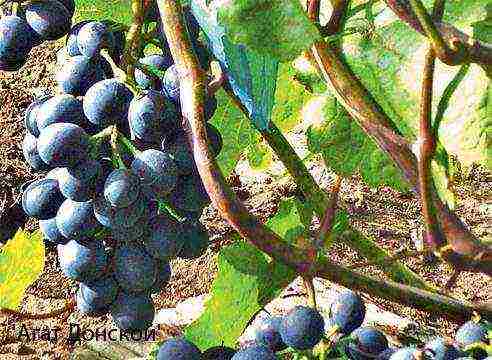
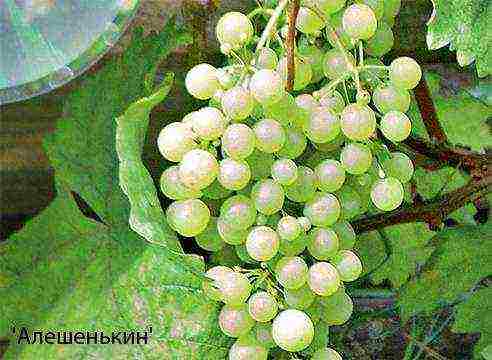

How to buy grape seedlings and rooting cuttings
The most reliable sources of planting material are winegrowers' clubs and forums, where enthusiastic and experienced gardeners and collectors communicate, as well as MOIP and TSKHA. You should not buy seedlings and cuttings at spontaneous roadside markets and exhibitions (of course, this does not apply to the stands of well-known nurseries).
How to buy grapes and choose a good seedling.
You can ask a question to the author of the article, wine grower Olena Nepomniachtchi, here .
You can find out how to grow other plants, what kind of gardening work you need to plan, from other articles on our website. Also, please pay attention to the information block to the left of the text. The links located in it lead to articles of related topics.

